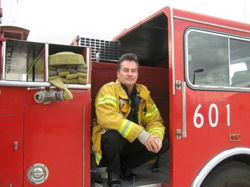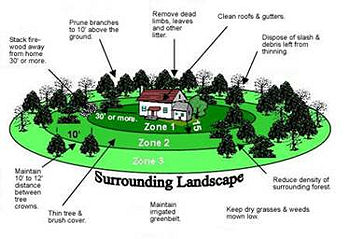
By Fire Chief Sam DiGiovanna, East County Magazine “In-House Fire Chief”
June 13, 2012 (San Diego’s East County)--Summer is here and brush fires are already happening throughout San Diego, Southern California and historic fires currently burning in Colorado and New Mexico.
Resources are being stripped from local areas and it’s important that homeowners do their part to mitigate the threat of wildfire protecting their property and to those that fight these fires with limited budgets due to our economy.
Let’s discuss some defensible space measures you as a homeowner can take “now” as we step right into fire season!
Wildfires are among the nation's growing natural hazards. Though wildfires are natural and often beneficial in less populated areas, more and more homes and lives are being threatened. Many states are implementing and enforcing regulations for reducing wildfire fuel sources. Be sure to check with your state or county for regulations related to your property.
All regulations for owners within or near canyons, brush-covered or grass-covered land, forest-covered or mountainous areas will include creating a defensible space. Regulations tend to be more stringent in areas with steeper terrain and denser vegetation. Creating a defensible space refers to reducing the fuel around a structure by separating, reshaping, trimming or removing the fuel sources. In California a defensible space clearing must be maintained around structures no less than 100 feet. A defensible perimeter allows firefighters an area to work in to protect structures. It also reduces the chance of spreading flames or burning ambers to nearby structures.
In all cases, dead, dry and woody vegetation must be removed. Plant material near structures should be regularly irrigated and well maintained, ornamentals, low-growing fire retardant shrubs, low-growing turf and succulent ground cover. Most guidelines will encourage the use of native plant materials especially in non-irrigated areas. Avoid planting in large clusters. It's best to create small planter beds or islands. Use decorative rock, flagstone, gravel or stepping stones to break up planter areas. Utilize mulch in planter areas, too. Mulch retains moisture, benefiting the nearby plant material, reduces weed growth and helps with erosion. There are many organic mulches, but avoid using confer or pine needles. These types of mulches catch fire quickly and will rapidly spread a fire. Owners should keep the surrounding areas near structures clean and free of debris, including fallen leaves and downed logs.

These are just a few guidelines for creating a defensible space to help reduce the spread of wildfires. Again, be sure to check with your local and state authorities for specific regulations in your area.
Other Fire Safety Tips:
- Remove dead and overhanging branches.
- Remove any branches within 10 feet of chimney vent.
- Clean all dead leaves and needles from roof and gutters.
- Install a roof that meets the fire resistance classification of Class C or better.
- Cover chimney outlet with a nonflammable screen of 1/4 inch or smaller mesh. Brand Guard Vents are a great alternative.
- Stack woodpiles at least 30 feet from all structures, fences, and other combustible material.
- Remove all stacks of construction materials, pine needles, leaves and other debris.
- Keep lawn chairs, umbrellas, and other canvas furniture a safe distance from structures
- Clear all vegetation and other combustible or flammable materials from beneath deck area.
- Enclose underside of elevated decks with resistant materials.
- Refrain from dumping lawn clippings in canyons.
- Identify at least two exit routes from your neighborhood.
- Make sure street names and house numbers are clearly visible.
- Designate an emergency meeting place outside your neighborhood.
- Immediately evacuate the area when ordered by police or fire personnel.










Comments
Creating Defensible Space
Thank you ECM for providing San Diego (and beyond) important Safety Information protecting our communities and those that live here!